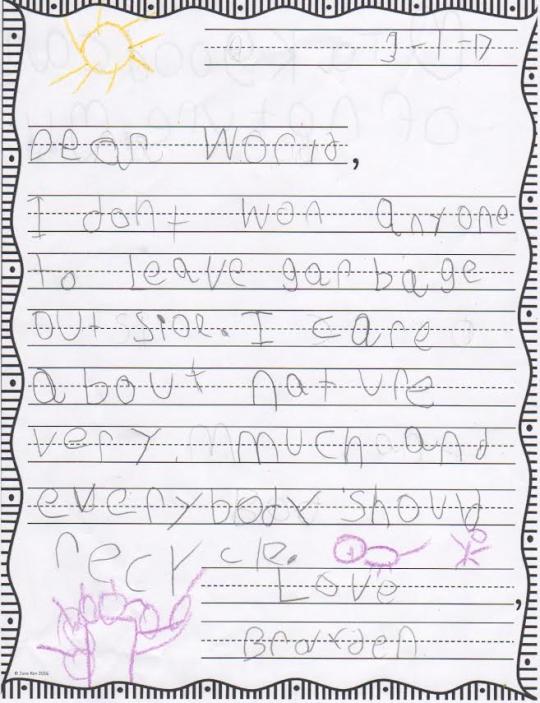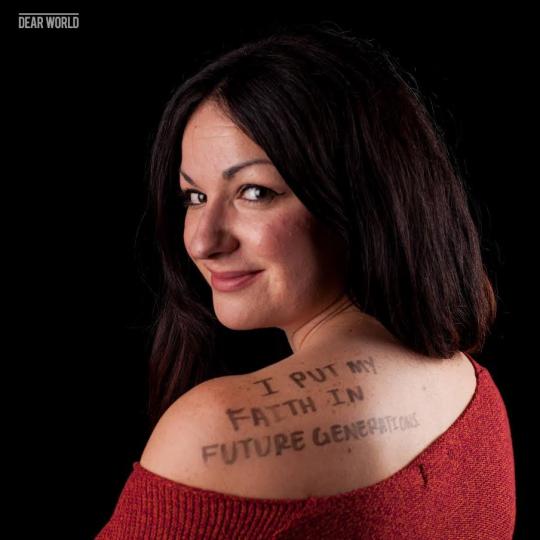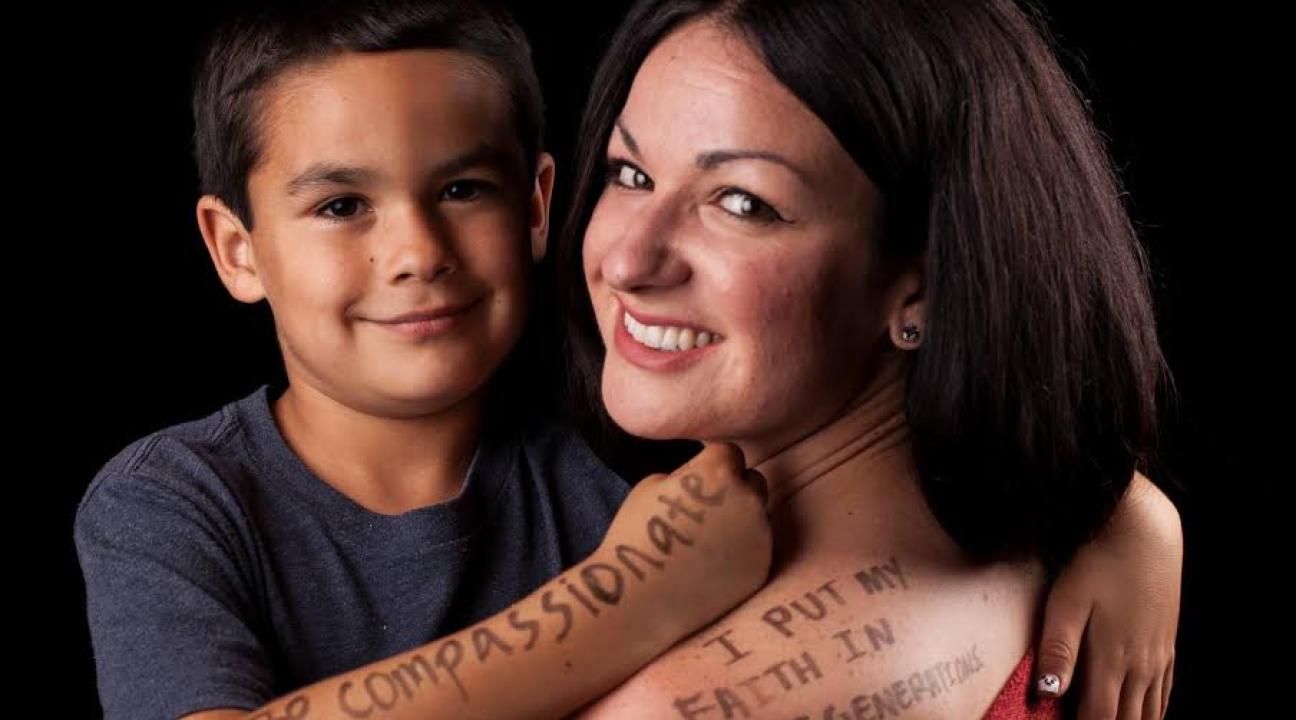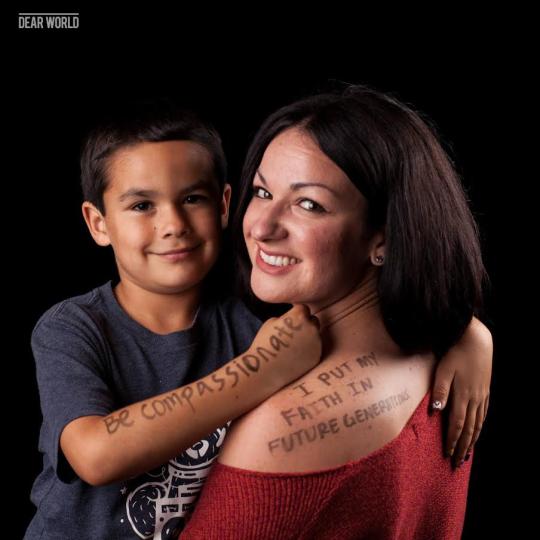Envisioning a Sustainable Future through Interdisciplinary Conversations and Conferences
While my class's first service-learning experience had a profound impact on most of my students, not all of my students "bought in" to the course goals completely until the service-learning project that followed. Our second service-learning project met in the first grade classroom of University Elementary at La Fiesta, a school just down East Cotati Avenue, which was founded as a partnership between the Cotati-Rohnert Park Unified School District and Sonoma State University in 2013. Each college student was assigned one or two first grade "buddies". My students were able to give back to the community by recreating an award-winning portrait project Dear World experience for the first graders to enjoy; the first graders benefited from the one-on-one writing assistance they received, in addition to the early exposure to college and being told that their voice could make a difference in the world. My college students' reflections and the elementary student and teacher reflections proved that the collaboration was mutually beneficial; both groups felt more inspired to create positive change in the world after this experience. The first grade teachers kept this momentum going by creating a blog so that the first graders could share their messages with their loved ones, this blog also hosts a video I created to document what the collaboration meant to my students.
Before that, my students gained the knowledge and experience from the assignments related to Dear World in preparation for our next step in civic engagement, which was looking to the future. Dear World's blog and live storytelling event was fundamental in our exploration of global discourse and the potential impacts that communicating across physical, social, and cultural barriers can have in terms of creating a more resilient world for the future. After completing the Dear World letter I assigned, my students and I volunteered for the Dear World organization, together, when they were brought to campus by ASP. Dear World asks people to share a story that only they can tell. We listened to the deeply personal stories of students, faculty, and other members of our campus community and helped them come up with a single, meaningful message to write on their skin before having their portrait taken and shared with the world. In my student's reflections, I noticed that this event had a significant impact on their developing identities as engaged global citizens and their desire to use writing as a tool for social change.

Dear World letter from first grader Brayden: "Dear World, I don't want anyone to leave garbage outside. I care about nature very much and everybody should recycle. Love, Brayden".
I've been fortunate enough to have the opportunity to present my service-learning curriculum twice this semester. The first conference I was a speaker for was the This Way to Sustainability Conference xii at California State University, Chico under the category Educating for Resilience, the second conference was a jointly hosted writing center conference, Crossings: Exploring Shared Work in Writing at University of Nevada, Reno. You might be thinking that a presentation on first year writing instruction would seem out of place at a sustainability conference or maybe that sustainability and writing have very little in common; we tend to look toward STEM fields for answers to sustainability, and since the potential for writing to impact the world is less tangibly evident then, let's say the student designed solar powered charging station on Chico State's campus, the important connection between writing and sustainability is often lost or missing from the conversation.
Presenting the same information at two very different conferences allowed me to start a dialogue with other educators from various disciplines about the important role Arts and Humanities have in exploring global issues. My presentation, titled, Dear World: Personal, Social, and Academic Crossings in First-Year Composition, gave an overview of the interdisciplinary service-learning model I developed for my English 100A/B stretch-course. In creating this course, I recognized that there is a natural overlap between the personal and social dimensions of any academic writing assignment and that by allowing students to explore these dimensions, we, as educators, have the opportunity to help shape a generation of resilient and civically engaged students, this is where service-learning becomes the most useful and dynamic "text" we can offer them.
During my Q&A time, at the sustainability conference, one attendee commented on the untapped potential for shared narratives in the scientific fields, "What good are these innovative solutions without the means to write about or share them?" I, too, could not have created this model without bringing a different way of thinking into my classroom. When reading through the reflections, it became clear to me that my students had as much to gain from the first graders, as the first graders had to gain from them, in the same way that my students' Dear World letters are what inspired my Dear World message: I put my faith in future generations. Service-learning has made all of this possible.
After presenting my service-learning model for a second time, at the Writing Center Conference in Reno, I encountered a literal crossing between composition and sustainability. A Composition Instructor from a nearby Community College informed me that her boyfriend had attended my presentation at the sustainability conference the week prior, and had recommended that she come and see me speak. When reflecting on this encounter, I am reminded by what I told my students when I assigned their final research and service-learning essay: although we cannot solve all the world's problems in one semester, we can hope that the work we do inspires the type of conversations that will. Conferences are all about starting these types of conversations.

Author: Ms. Emily Seder



